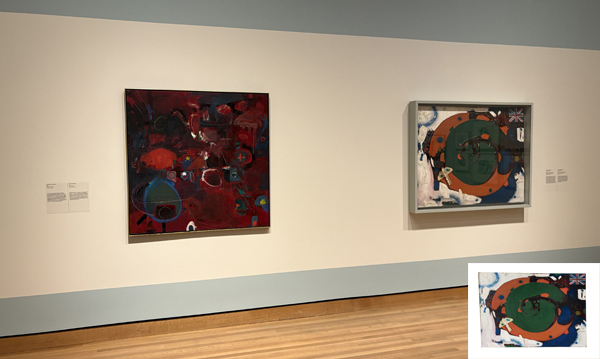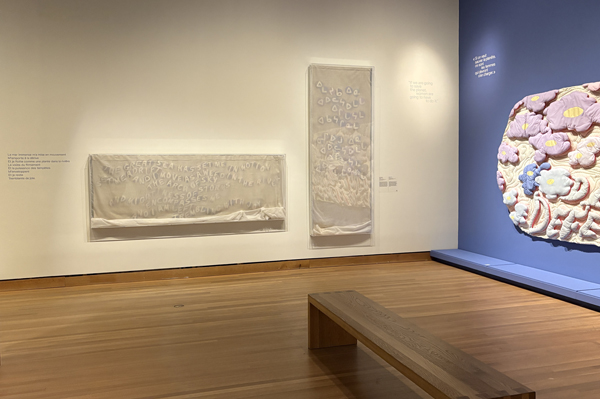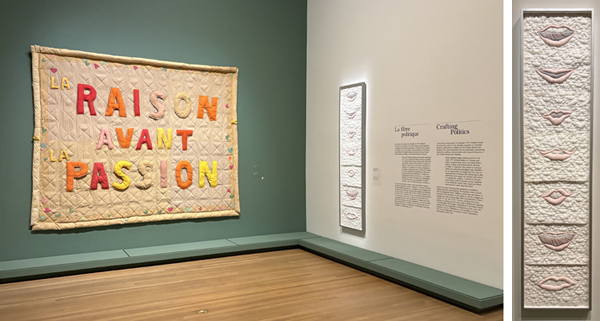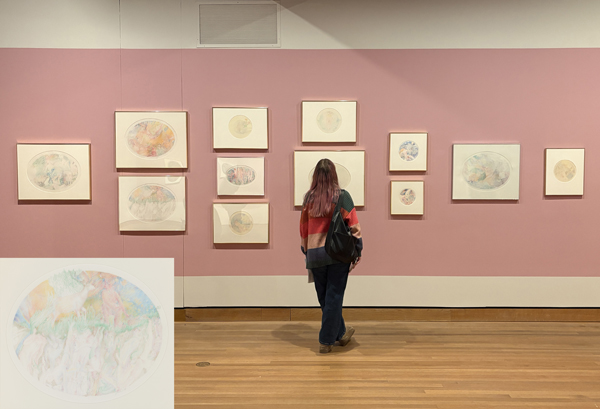Joyce Wieland: Heart On
By: ArtBank / 02 April 2025Canadian multidisciplinary artist, feminist and ecological advocate Joyce Wieland (1930–1998) is currently the subject of a long-anticipated retrospective. Co-curated by Anne Grace, Curator of Modern Art at the Montreal Museum of Fine Arts, and Georgiana Uhlyarik, Fredrik S. Eaton Curator of Canadian Art at the Art Gallery of Ontario, Joyce Wieland: Heart On is the first large-scale exhibition in almost 40 years devoted to this important artist and filmmaker. The Canada Council Art Bank, home to 17 works of art by Wieland, is supporting the landmark exhibition through its loan program.

Exploring Laura Secord
Heart On traces Wieland’s diverse ways of working and the subjects she explored across her career. It begins with a selection of her formative paintings and drawings from the 1950s and 1960s, including a work held in the Art Bank collection, Laura Secord Saves Upper Canada (1961). The work exalts the War of 1812 heroine, who stood out to Wieland as a young schoolgirl weary of the male-focused narratives dominating Canadian history.
Recalling this anecdote as an emerging artist seeking her own form of expression, Wieland imagined Secord’s circuitous route as an interconnected red-and-green spiral seen from above. The path is marked by chalk arrows and numbers, and a paper airplane is attached to the canvas, hinting at the school setting where Wieland first encountered Secord. Other elements such as layered, sprayed and dripped paint incised with text create an abstracted retelling of a historical moment and the artist’s own memories, through contemporary visual language.

True patriot love?
Many works from True Patriot Love appear in Heart On, including The Great Sea (1970–1971), which is held in the Art Bank collection. It is part of a grouping that complicates Wieland’s settler perspective while honouring her progressive advocacy for Arctic sovereignty and preservation of natural resources. The diptych rug hooking consists of an Inuit verse, “Aii Aii” or “The Great Sea,” by Uvavnuk, who sings that she was transformed into a shaman after being struck by a meteor. The work is arranged as two sets of rug-hooked letters, one in Inuktitut and one in English, set behind curtains of gossamer fabric and inside Plexiglas cases. It was originally intended as a triptych but was not completed for the 1971 exhibition and, fittingly, a French translation of the verse appears at the left in Heart On.
The maquette for the government book Wieland dismantled and reconstructed with photographs, handwritten annotations, clippings and pressed flowers to accompany True Patriot Love appears in a nearby vitrine. The pages pasted with copies of the “Aii Aii” song in Inuktitut, French and English, and photographs of both the sea and The Great Sea, which is visible in the distance, are part of the installation.

Femininity as politics
Wieland’s celebrated monumental quilted, stitched and knitted works are situated at the heart of the exhibition. Maple Leaf Forever II (1972) is held in the Art Bank collection and appears in this section. It is a work that combines aspects of Wieland’s drawing, filmmaking and quilting practices. A series of quilted, puffed female lips coloured with pencil and stacked top to bottom form the syllables of the titular song, which was optioned as Canada’s national anthem in the 1960s.
As with other works of the period that foreground Wieland’s “lip animation”—such as the lipstick lithograph O Canada (1970) and the film Pierre Vallières (1972), both included in Heart On—the sequencing of morphing syllables recalls the narrative inherent to a film strip. A maple leaf pattern quilted across the background is a tongue-in-cheek play on the title, one of many examples of Wieland injecting humour into her art.

Drawing interconnectedness
Closing out Heart On are Wieland’s lesser known, though no less significant, drawings and paintings from the late 1970s and into the early 1990s. Among these is a group of coloured-pencil drawings stemming from her filmmaking practice and shown at her 1981 exhibition, The Bloom of Matter. As Wieland noted of these works: “I’m working now with little drawings of different female mythological characters. They are tiny, pale-coloured sketches done with coloured pencils… They’re full of light. They’re full of skies.”
One of the 32 drawings in The Bloom of Matter, which is also included in Heart On and is held in the Art Bank collection, is The One Above Waits for Those Below (1981). A vibrant, mythological goddess, a stag and a loon preside above a colourless underworld populated by people and animals who reach upward, as if they seek to both nurture and grow out of the earth itself. These drawings evoke the ecological interconnectedness that Wieland championed throughout her career, while signifying her return to figurative drawing and painting after almost three decades. Since her death in 1998, Wieland’s works have been commended for their poignant insight into Canadian society and politics in the second half of the 20th century, and as assertions on gender equality, ecological policies and national ideologies. They are calls to action that continue to resonate today.
Joyce Wieland: Heart On is on display at the Montreal Museum of Fine Arts until May 4, 2025, followed by a presentation at the Art Gallery of Ontario from June 21, 2025, to January 4, 2026. Pieces in the Canada Council Art Bank’s collection are available for rent by corporate workspaces and are accessible to museums and galleries through the loan program.

About the Author: Julie Nash
Julie Nash is an Ottawa-based art historian and curator whose areas of study include connections between Canadian and international art in the 20th century. She has worked at the Art Gallery of Ontario and National Gallery of Canada.